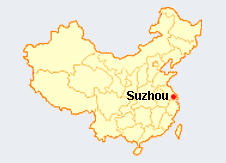Win a coupon
Your opinion is vital for us to improve our service and further to offer you an excellent China trip. Now, your golden ideas are needed and they may earn you a coupon. Join us for your chance to win a prize!
With your green fingers make an easy but visible difference to the environment along your trip way
Home > China Guide > Suzhou
Suzhou is a tiny city situated at the Yangtze River Delta. Detail-filled gardens, museums, old canal scenes, temples and bridges can unveil you the local traditional charm.

Suzhou Tourist Attractions
Humble Administrator's Garden Lingering Garden The Master of Nets Garden Suzhou No.1 Silk Factory




Known as the Venice of the east, Suzhou is located at the center of Yangtze Delta and on the shores of Taihu Lake. Along with the two nearby cities of Shanghai and Nanjing, Suzhou makes up modern China's richest region. Yet it still owns a long history of 2500 years. Built in 514 B.C, it was first set up as the capital city of Wu Kingdom during the Spring and Autumn and Warring State Period. It is where the Wu culture sprang from. After Wu fell apart in 473 B.C, the city was coquetted and did not retain its glory until the Grand Canal was built in Sui Dynasty during around 6 century, when the city got its present name. Since then, Suzhou has been destroyed several times but survived intact. It was under sever destruction during Japanese invasion in 1930s, but restoring projects started since 1980s. In 1997 and 2000, nine classic gardens including Humble Administrator's Garden, Lingering Garden, Master of the Nets Garden, Mountain Villa with Embracing Beauty, Canglang Pavilion, Lion Forest Garden, Garden of Cultivation, Couple's Garden Retreat and Retreat & Reflection Garden were listed on World Heritage Sites by UNESCO.
What its long history leaves to Suzhou includes classic gardens, lakes, canals and all sorts of traditional structures such as temples, ponds, pagodas, and arched stone bridges. Dating from the 11th-19th century, classic gardens in Suzhou are generally acknowledged as masterpieces of the genre, reflecting the profound metaphysical importance of natural beauty in Chinese culture, especially Chinese classic paintings and architectures, in their meticulous design. Among them, the Humble Administration Garden is a must, where the large lake, pavilions and walk paths assure visitors a comfortable afternoon. Other attractions like Lingering Garden are also suggested. If you are a history enthusiast, Suzhou Museum right next to Humble Administration Garden may be a place to your taste, where you can have a brief glimpse of Suzhou's long history through its more 15,000 pieces of collections like ancient calligraphies, paintings, ceramics, crafts, unearthed relics, revolution relics, etc. Other attractions include Tiger Hill, where the ancient King of Helu was supposed to be buried on, Pan Gate, built in 514 B.C and has become one of the prime tourist destinations along with other attractions nearby, just to name a few.
Apart from traditional structures mentioned above, more cultural heritages are also expected in Suzhou, such as silk, embroidery, jade and wood carving works, Chinese paintings, calligraphies, Kun operas, etc. All are quintessence of handicrafts Suzhou people has passed on generation after generation for more than 2000 years. They represent China's cultural traditions and treasures to some extend. Moreover, Suzhou Cuisine is one of the three most famous cuisines in China, representing the taste of Eastern China (with the other two being Guangdong Cuisine representing Southern China and Beijing Cuisine representing Northern China). For snacks, visitors will not neglect the numerous eateries in Suzhou. But be cautious for the sanitary conditions, especially of small private vendors. If you have decided to come, come in spring, when Suzhou is warm, gender, and soft, just like beauties Suzhou has been famous for.
- Air quality:★★★★☆
- Foreigner-friendly degree: ★★★★☆
- Public security degree: ★★★★☆
- Hygienic degree: ★★★★☆
- Traffic jam degree: ★★★☆☆
- Internationalization level: ★★★★☆
- Consumption level: ★★★★☆
- Language:Suzhou dialect (Wu Chinese), Mandarin
- Best traveling season: Apr. to Oct..
- Tourist resources: historic relics, culture
- Airport to downtown: 100 km from Shanghai Hongqiao Airport
- Demographics: Han (99.45%)
- Key words: private garden, beauties, prosperous, food, shopping, tea, silk
Local Delicacies:Biluochun Tea Flavored Shrimp Meat (Biluo Xiaren 碧螺虾仁), Bamboo Shoot Soup with Bacon (Sunyanxian 笋腌鲜), Steamed Chicken Soup in Water Melon (Xiguaji 西瓜鸡), Fried Shrimp (Qingchao Sanxia 清炒三虾), Fish Liver Soup (Bafeitang鲃肺汤), Steamed Crab (Dazhaxie 大闸蟹), Herring Tail (Qingyushuaishui 青鱼甩水), Lvyang Wonton (Lvyang Huntun 绿杨馄饨), Sweet and Sour Mandarin Fish (Songshu Guiyu 松鼠桂鱼), Soft-shelled Turtle Soup (Baizhi Yuancai 白汁鼋菜), Snakehead Fish Soup with Water Shield (Chuncai Tuntangpian 莼菜氽塘片), Pan Fried Pork Bun (Yaba Shengjian 哑巴生煎).
Local Specialities: Su Embroideries (Suxiu 苏绣), Silk (Sichou 丝绸), Biluochun Tea (Biluochun Cha 碧螺春茶), Su Fan (Su Shan 苏扇), Song Brocade (Song Jin 宋锦), Taohuawu Wood Engraving Spring Festival Pictures (Taohuawu Muke Nianhua 桃花坞木刻年画), Dried Bean Curd (Doufugan 豆腐干), Wedding Dress (Hunsha 婚纱), Pearl (Zhenzhu 珍珠).
- 苏州市旅游局 Suzhou Tourism Administration Service
- 0512-65305887
Useful lines:


